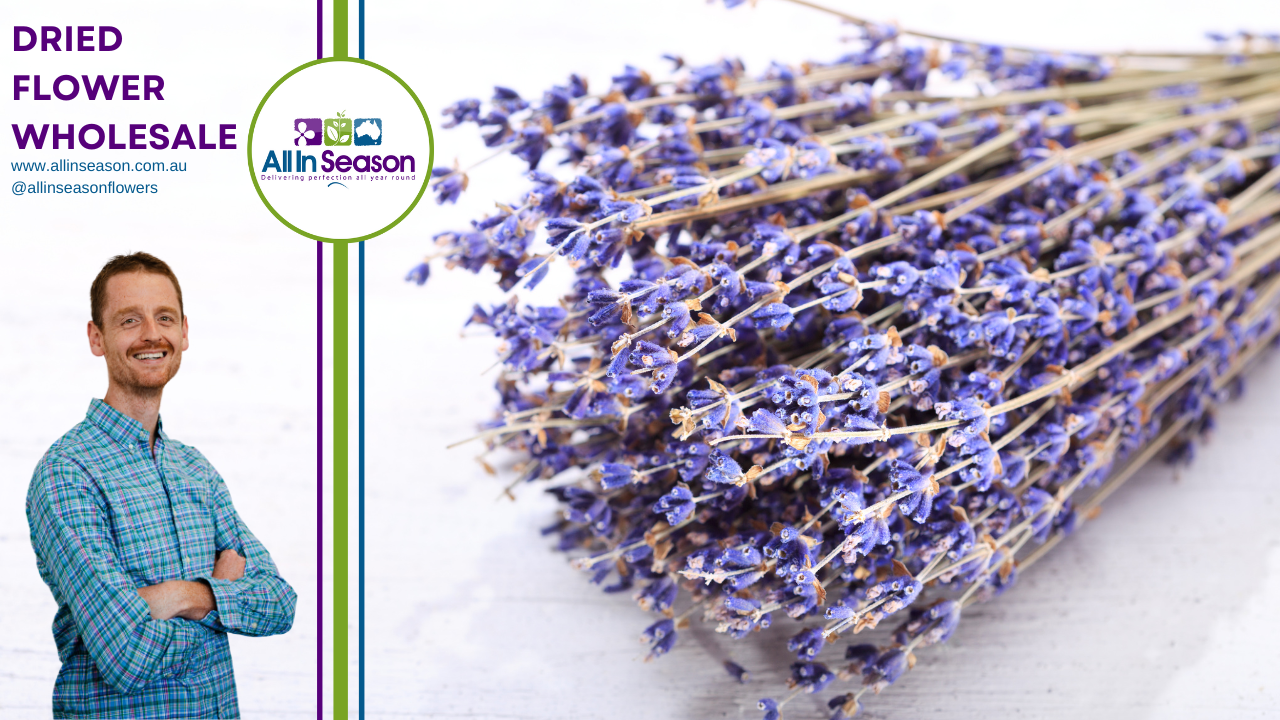Blog Article Australian Dried Lavender | All InSeason
Author: Ader Broersen - All InSeason Australia Date Posted:12 January 2024
Australian Dried Lavender, what’s not to love?
Indeed, we all love Lavender, but more specifically, we love Australian Grown Dried Lavender. The beautiful fragrance sets it apart from other flowers, but when it's dried, it makes it everlasting, and when you add the fact that it's Australian Grown, supporting local, it makes for an absolute winner.
When is the Lavender season in Australia?
Visiting a Lavender Farm is an experience on its own. You are guaranteed to come home with stunning photos and bags of lavender products like essential oils, soaps and candles, and most offer a great culinary experience with a beautiful café or restaurant, making it a great all-around experience.
The perfect time to visit an Australian Lavender Farm is between November and January, but some French Lavender actually flowers nearly all year round. While you can visit most farms anytime, visiting around New Year will ensure you’ll enjoy it all, creating everlasting memories.
Recommended Lavender Farms
We’ve visited Porth Arthur Lavender, Tasmania, which is absolutely worth the visit. And if it's not for the Lavender, the café, where the food and views are excellent.
In Queensland, we’ve been to Kooroomba Vineyard and Lavender Farm near Boonah. Another unique place we can highly recommend, and dining in its award-winning restaurant is a must.
But Australian Lavender is grown almost everywhere, so a Lavender Farm must be near you. If you want to explore more farms, check out this great resource.
How to dry Lavender
If you want to preserve the beautiful fragrance of Lavender, you can dry them. The process is straightforward, and you can use the Lavender in your garden.
Just remember that not all Lavender types have the same fragrance. For example, French Lavender isn’t as fragrant as others.
Step 1
Select a handful of stems just before the buds transform into flowers, at their peak of fragrance and vibrancy. Once dried, incorporate them into scented sachets, potpourri, or a dried floral arrangement. For optimal results, opt for English lavender because it is known for its higher oil content than other varieties.
Step 2
Trim the stems, including leaves and buds, focusing on the bud clusters, which possess the highest concentration of fragrant oils. Bunch the stems in loosely tied bundles to prevent mildew formation. Mould is more likely in larger bunches where moisture may be trapped.
Step 3
Bunch the stems with a string or rubber band, ensuring to leave one end long enough for hanging. Suspend the bundles upside down in a cool, dry location shielded from direct sunlight, as extended exposure to the sun can cause the colour to fade.
Step 4
Regularly inspect the bundles every few days to confirm the drying process and prevent mould development. The complete drying of Lavender typically takes between one and two weeks, depending on the bunch sizes and humidity levels.
If you want more information about different types of Lavender and how to grow Lavender, this BHG page is a great starting point.
Not all Lavender types have the same fragrance. For example, French Lavender isn’t as fragrant as others.
Tips for storing Australian Dried Lavender
We have listed a few tips to get the most value out of your dried Lavender because it’s essential to maintain the quality and fragrance. Here is what you need to know:
· Avoid direct sunlight, or even better, store in a cool and dark place. Exposure to heat and sunlight can reduce the fragrance and cause the colour to fade.
· Avoid high humidity. Ziplock bags or airtight containers are great for keeping the moisture out. Moisture does affect dried Lavender and can even develop mould, so this is an excellent way of keeping your dried Lavender fresh. (Displaying your dried Lavender bunches in Bathrooms, for example, is therefore not the best idea)
When the scent is diminishing a little over time, there is a way to revitalise it again. To refresh the scent, crush some petals or add a few drops of lavender essential oil to the Ziplock bag or container.

How to get creative with lavender
While there are lots of ways to get creatives with dried lavender, we did do some research for you, so you don’t have to!
-
Find craft inspiration, and get 25 instant lavender craft ideas!
-
Find lavender wedding floral ideas to help you find ways to use lavender at your wedding. (Or check out our article about dried and preserved wedding flowers in Australia to explore more)
-
Find 13 Lavender Cake Ideas. Dried flowers can be used as cake toppers, but there are many other ways as well! (Want to know more about dried flowers in cake designs? Please read our article; The secrets about dried flower cake decorations).
-
Find lavender bouquet and arrangement ideas, and be amazed by the possibilities.
Our dried lavender
Here at All InSeason, we offer high-quality dried lavender at wholesale prices. All our dried lavender is sourced from local Australian growers and is certified Australian Grown. For more information about our Australian-made licence, read our article Australian-Made Licence Approved.

What should be your takeaways:
-
The best time to visit Australian Lavender Farms is between November and January.
-
Avoid direct sunlight and humidity to get the most value from your dried lavender.
-
Dried lavender is great to use in crafts, weddings, cake designs and fresh and dried floral arrangements.
-
All InSeason’s Dried Lavender is Australian-Made Licence Approved.
What’s next:
-
View our Australian-grown dried Lavender
-
Browse our Australian-grown dried and preserved flowers.
-
Browse our complete range of dried and preserved flowers.
About the author
Ader Broersen – Ader is Co-owner, Marketing & Sales Director at All InSeason Australia & New Zealand | 20+ years of experience in the agricultural/flower industry both in Holland and Australia with a passion for flowers.
Comments (1)
kaylasquire
By: Dried Flowers on 23 January 2024Thanks for the insightful guide on Australian Dried Lavender! The fragrant details are fascinating. Great job!











